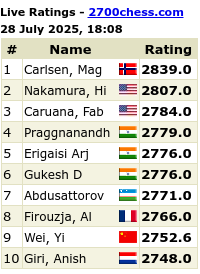1.d4 Nf6 2.c4 e6 3.Nc3 Bb4 4.e3 0-0 5.Bd3 c5 6.Nf3 d5 7.0-0 cxd4 8.exd4 dxc4 9.Bxc4 b6 10.Bg5 Bb7 11.Re1 Nbd7 12.Rc1 Rc8 This position also occured in the Kramnik-Kasparov WC 2000 match where Kramnik chose 13.Qb3.
13.Bd3 Re8 14.Qe2 Bxc3 15.bxc3 Qc7 16.Bh4 Nh5 17.Ng5 g6 18.Nh3 The novelty. In Psakhis-Hillarp Person, 2000, White chose 18.Qd2 instead.
18...e5 19.f3 Qd6 20.Bf2 exd4 21.Qxe8+ Rxe8 22.Rxe8+ Nf8 This exchange of queen for two rooks, yields a complicated middlegame almost entirely centered around piece-play. The reason is that the queenside pawns of both sides are fairly vulnerable if ignored, and the best way to protect them is via active play with the pieces. Obviously neither side will go about committing suicide by opening up the kingside pawns since mating patterns have a nasty way of turning up at lightning speed when one does. So bottomline, who is better? If one had to choose a side, it would be White, not so much for the bishop pair, which are doing little here, but for the rooks, which can often coordinate to overwhelm the queen's ability to hold the fort.
23.cxd4 Nf6 24.Ree1 Ne6 25.Bc4 Bd5 26.Bg3 Qb4 27.Be5 Nd7 28.a3 Qa4 29.Bxd5 Nxe5 30.Bxe6 If 30.dxe5 Black would recover the piece with 30...Qd4+ 31.Nf2 Qxd5
30...Qxd4+ Although this is the obvious move, it may not be best. The reason is that this materialistic grab of d4 followed by the capture on e6 will open the Bulgarian's king to rook threats on the 7th, precisely what White wants. 30...Nd3 31.Rc4 Qxa3 32.Bxf7+ Kxf7 33.Ng5+ Kf6 34.Ne4+ Ke6 35.d5+ Ke5 36.Rf1 and the difference here is that Black's king is not locked in a cage, awaiting the killing blow.
31.Kh1 fxe6 32.Ng5 Qd6 33.Ne4 Qxa3 34.Rc3 Qb2 35.h4 b5 36.Rc8+ Kg7 37.Rc7+ Kf8 38.Ng5 Veselin is now in deep trouble, maybe even objectively lost.
38...Ke8 39.Rxh7 Qc3 40.Rh8+? Argh! The collective sound of groans and comments of consternation by kibitzing amateurs and GMs was heartfelt. Right on the 40th move, to make the time-control, the World Champion does the unthinkable. He unlocks the cage and sets the Challenger's king free. Better was 40.Re4 b4 41.Rxa7 b3 42.Rb7 b2 43.Kh2 Qc1 44.Ra4 Nd7 45.Rab4 which would pretty much quash Black's hopes for good.
40...Kd7 41.Rh7+ Kc6 42.Re4 b4 43.Nxe6 Kb6 44.Nf4 Now Topalov is at a fulcrum and must choose the best way to proceed. There is no question the position is treacherous.
44...Qa1+?! Alas for the fans of the Bulgarian genius this is second best. This plan with Qa1+ is to support the queenside advance with a5 and push both a and b pawns. The problem is that this plan is too slow, and the king is still exposed. More incisive was 44...Qc1+! 45.Kh2 Nc6 46.Nxg6 b3! and the racing b-pawn doesn't allow White time to dictate the proceedings. 47.Nf4 Qd2 48.Rh6 b2 49.Rc4 b1Q 50.Rhxc6+ Ka5 51.R6c5+ Ka6 52.Rc6+ Ka5
45.Kh2 a5 46.h5! Opening lines for the rook.
46...gxh5 47.Rxh5 Nc6 48.Nd5+ Kb7 49.Rh7+ White is winning now.
49...Ka6 50.Re6 Kb5 51.Rh5 Nd4 52.Nb6+ Ka6 53.Rd6 Kb7 54.Nc4 Nxf3+ 55.gxf3 Qa2+ 56.Nd2 Kc7 57.Rhd5 This is an imprecision. It isn't that Black is suddenly doing well, but the rooks would work better if they could threaten from afar.
57...b3 58.Rd7+ Kc8 59.Rd8+ Kc7 60.R8d7+ Kc8 61.Rg7 a4 62.Rc5+?? This is a blunder, and suddenly Topalov can see a light at the end of the tunnel. The straightforward 62.Rdd7 was preferable. For example: 62...a3 63.Kg3 Qa1 64.Rc7+ Kb8 65.Rb7+ Ka8 66.Nxb3
62...Kb8 63.Rd5 Kc8 64.Kg3?? Twice offered the chance to finish his opponent off, and twice he slips. One could point to any number of factors to account for this: rustiness (hardly), age (not likely), nerves (possibly), and physical preparation. Nerves would be the obvious explanation, and could easily be the correct one, but the last one, physical preparation, cannot be overlooked. The blunders we are seeing, barring the odd first game, have begun appearing in the latter part of the match, and at later stages of the game, when the players have been sweating it out for hours already. Fatigue, and thus conditioning, could also easily explain these lapses of concentration.
64...Qa1 65.Rg4 b2 66.Rc4+ Kb7 67.Kf2 b1Q 68.Nxb1 Qxb1 69.Rdd4 Qa2+ 70.Kg3 a3 71.Rc3 Qa1 72.Rb4+ Ka6 73.Ra4+ Kb5 74.Rcxa3 Qg1+ 75.Kf4 Qc1+ 76.Kf5 Qc5+ 77.Ke4 Qc2+ 78.Ke3 Qc1+ 79.Kf2 Qd2+ 80.Kg3 Qe1+ 81.Kf4 Qc1+ 82.Kg3 Qg1+ 83.Kf4 1/2-1/2
[Analysis by Chessbase]
Thursday, May 06, 2010
Subscribe to:
Post Comments (Atom)

No comments:
Post a Comment